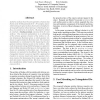Free Online Productivity Tools
i2Speak
i2Symbol
i2OCR
iTex2Img
iWeb2Print
iWeb2Shot
i2Type
iPdf2Split
iPdf2Merge
i2Bopomofo
i2Arabic
i2Style
i2Image
i2PDF
iLatex2Rtf
Sci2ools
CVPR
2001
IEEE
2001
IEEE
Bending Invariant Representations for Surfaces
Isometric surfaces share the same geometric structure also known as the `first fundamental form'. For example, all possible bending of a given surface, that include all length preserving deformations without tearing or stretching the surface, are considered to be isometric. We present a method to construct a bending invariant canonical form for such surfaces. This invariant representation is an embedding of the intrinsic geodesic structure of the surface in a finite dimensional Euclidean space, in which geodesic distances are approximated by Euclidean ones. The canonical representation is constructed by first measuring the inter geodesic distances between points on the surfaces. Next, multi-dimensional scaling (MDS) techniques are applied to extract a finite dimensional flat space in which geodesic distances are represented as Euclidean ones. The geodesic distances are measured by the efficient `fast marching on triangulated domains' numerical algorithm. Applying this transf...
Computer Vision | CVPR 2001 | Geodesic Distances | Inter Geodesic Distances | Intrinsic Geodesic Structure | Invariant Canonical Form | Similar Geodesic Structures |
| Added | 12 Oct 2009 |
| Updated | 12 Oct 2009 |
| Type | Conference |
| Year | 2001 |
| Where | CVPR |
| Authors | Asi Elad (Elbaz), Ron Kimmel |
Comments (0)

